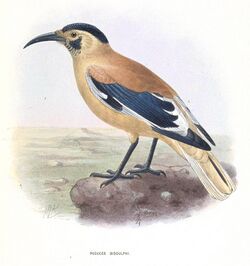Biology:Xinjiang ground jay
| Xinjiang ground jay | |
|---|---|

| |
| Illustration by John Gerrard Keulemans in 1891 | |
| Scientific classification | |
| Domain: | Eukaryota |
| Kingdom: | Animalia |
| Phylum: | Chordata |
| Class: | Aves |
| Order: | Passeriformes |
| Family: | Corvidae |
| Genus: | Podoces |
| Species: | P. biddulphi
|
| Binomial name | |
| Podoces biddulphi Hume, 1874
| |
Xinjiang ground jay (Podoces biddulphi) or Biddulph's ground jay, is a species of bird in the family Corvidae. It is endemic to China . It is not larger than an adult human's hand and has a brownish white coat of feathers.
Since 2004, the International Union for Conservation of Nature (IUCN) has listed the jay's conservation status as "Near Threatened" due to habitat fragmentation and degradation.[1] Its population is small, and its range is limited.[2]
Breeding
The breeding season lasts from March to May.[2] Females incubate clutches of 1-3 eggs for 18 days[2] in open[3] nests; they mainly incubate in the morning, and spend more time doing so if temperatures are low. When temperatures are high, they also shade the clutch. They prefer to nest toward the center of oases.[2]
Parents share feeding duties.[2]
Xinjiang ground jays are monogamous. They exhibit sexual dimorphism, and males are larger than females.[2]
They are sometimes attracted to human-influenced areas such as highways,[4] but prefer not to nest near them.[5]
References
- ↑ 1.0 1.1 BirdLife International (2017). "Podoces biddulphi". IUCN Red List of Threatened Species 2017: e.T22705888A111661838. doi:10.2305/IUCN.UK.2017-1.RLTS.T22705888A111661838.en. https://www.iucnredlist.org/species/22705888/111661838. Retrieved 13 November 2021.
- ↑ 2.0 2.1 2.2 2.3 2.4 2.5 Wang, Kechun; Tong, Yuping; Xu, Wenxuan; Blank, David; Yang, Weikang; Xu, Feng (November 2023). "Breeding biology of the Xinjiang ground-jay Podoces biddulphi in the Taklimakan Desert, NW China". Global Ecology and Conservation 47: e02690. doi:10.1016/j.gecco.2023.e02690. ISSN 2351-9894. http://dx.doi.org/10.1016/j.gecco.2023.e02690.
- ↑ "Figure 1: Variation in egg reflectance under five treatments over 7 days.". doi:10.7717/peerj.11725/fig-1.
- ↑ Bunce, R.G.H.; Bogers, M.M.B.; Evans, D.; Jongman, R.H.G. (October 2013). "Field identification of habitats directive Annex I habitats as a major European biodiversity indicator". Ecological Indicators 33: 105–110. doi:10.1016/j.ecolind.2012.10.004. ISSN 1470-160X. http://dx.doi.org/10.1016/j.ecolind.2012.10.004.
- ↑ Madge, Steve (2020-03-04), "Iranian Ground-Jay (Podoces pleskei)", Birds of the World (Cornell Lab of Ornithology), doi:10.2173/bow.irgjay1.01, http://dx.doi.org/10.2173/bow.irgjay1.01, retrieved 2023-12-26
Wikidata ☰ Q2668081 entry
 |


